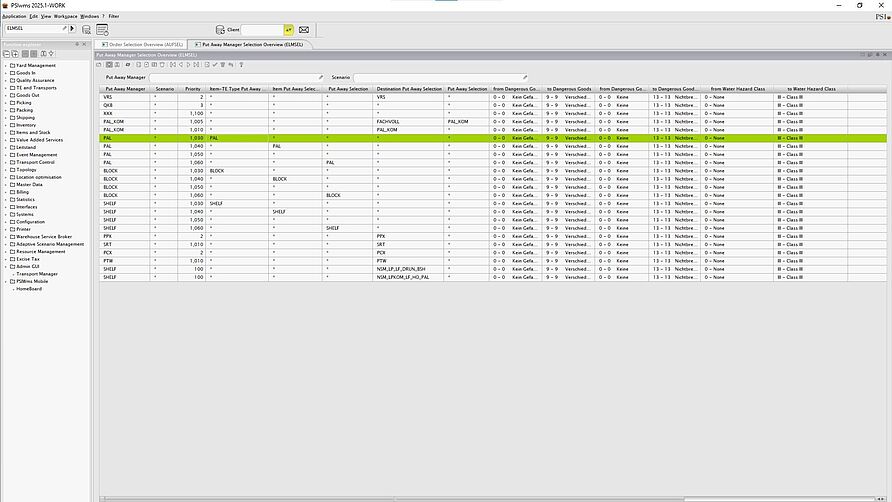So-called rule sets have proven to be particularly helpful in everyday warehouse logistics. These are automated decision guidelines that support users and enable smooth processes.
What advantages do WMS rule sets offer?
Decisions are made when there are no fixed guidelines. The problem: employees rarely make uniform decisions. Instead, they are guided by their individual experiences and act intuitively. As a result, work processes differ from colleague to colleague and consistent warehouse management in all aspects is difficult to achieve.
For reproducible decisions, automated rule sets can be integrated that formulate fixed instructions based on predefined input criteria. This provides employees with clear guidelines, which minimizes the error rate and reduces the time required. With precise instructions from the set of rules, the user does not even require any warehouse-specific prior knowledge and employees from outside the department can also be deployed flexibly.
What is special about the rules and regulations in PSIwms?
PSI's Warehouse Management System offers sets of rules for standardized warehouse processes. It is characterized in particular by its consistent configurability in all areas. From goods receipt and putaway to orders, routing and dispatch: PSI rules can be used in all areas of the warehouse and can be configured individually.
Information can be evaluated in the various sets of rules: e.g. on notifications, orders, articles and storage units used. If data cannot be stored directly in a rule table, it is possible to expand the specific data using additional parameters via SQL queries.

Rules can be weighted against each other - an important detail for setting priorities. The table-based PSI rule set evaluates the rules enriched with data against each other and sorts them according to priority. The rule with the most restrictions is therefore the one that is checked first for relevance. This means that the employee is always sure to apply the correct process, even in situations where several rules clash. The different sets of rules cannot block each other.
Best practice: use cases of the WMS rules and regulations
A particularly illustrative use case for a WMS control system can be found in the area of storage. An item that is transported on a Euro pallet, for example, is always stored in the pallet rack. If the same item arrives in a box, it is stored on a shelf. This specification can be defined in the rules and regulations. Special cases are also handled without any problems. If, for example, the pallet rack is completely full, a different strategy can be implemented using a downstream rule or a "catcher line". In the example of the full pallet rack, the system could instruct the employee to store all further pallets in block storage. This means that the user does not have to make any independent decisions, even if the racks are full, but can rely on the rules and the strategies they contain.
Occasionally, it happens that no specific match can be found in the set of rules.
For this purpose, the PSI rule set has a so-called catcher line, which forms the last line of a rule set. All queries that cannot be assigned to a specific rule are caught here. If this occurs, the system instructs the employee, for example, to store the product in question in a collection point (or a "clarification point") or issues an error message that can be processed by the control center.
The flexibility of a WMS rule set can also be illustrated well using specific products, regardless of their carrier unit. For example, the company can provide high-value product groups, which should always be stored in closed areas for safety reasons, with corresponding additional information that is prioritized above the carrier unit. With the necessary data enrichment, the set of rules can differentiate between product class and carrier unit, for example, and thus determine the intended storage location.
Why sets of rules are initially perceived as "exhausting"
Although WMS rules and regulations make employees' work much easier, they are often perceived as "exhausting" during the configuration phase. The reason: in order to create a fixed set of rules for ongoing processes, the company must first define exactly what the individual workflows should look like. Therefore, it involves a certain amount of planning and at first glance may seem like tedious work. However, if carried out carefully, this task will pay off early. To make it easier for users to get started with the configuration so that they can derive maximum benefit from the concept, there are general aspects that need to be considered when creating a WMS set of rules.
As a first step, the company should familiarize itself with the individual use cases in order to be able to define them specifically in the PSIwms rules. As the system categorizes the respective applications according to priorities, it is important in the second step to weight the defined cases against each other and to arrange them according to their relevance in the table function of the rule set.
Conclusion: less stress and more security
If employees are left to their own devices, they make intuitive decisions that differ greatly from one another and can lead to faulty processes.
The set of rules in PSIwms is based on a table in which all rules are prioritized. In practice, several rules come together and the rule with the highest priority is ultimately applied.
The PSI set of rules is characterized by overflow rules ("catcher line"). If no specific rule can be assigned to a query, for example during putaway, the catcher line is applied as the last rule. In this case, the user is prompted to move the product to a clarification area, for example.
The configuration of a WMS set of rules requires a lot of planning. Each rule must be clearly defined by the company and it is important to weigh them up against each other to determine priorities. If the company takes a close look at its desired rules during the configuration phase, it will benefit from structured warehouse logistics in the long term.

![[Translate to English:] [Translate to English:]](/fileadmin/_processed_/d/5/csm_composing-psiwms-regelwerke-de_9b6c3cf95f.jpg)


